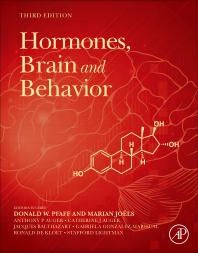Books in Neuroscience
Elsevier's Neuroscience collection empowers educators, researchers, and students with actionable knowledge to drive collaborative research and advancements in the field. Content covers the nervous system's intricate workings, covering branches like Affective, Behavioral, and Cognitive neuroscience to investigate the neural basis of emotions, behavior, and cognitive functions. Spanning from Molecular and Cellular Neuroscience to Developmental Neuroscience, content provides insights into brain function in health and disease.
- 1st Edition
- December 15, 2016
- George Fink
- English
- Hardback9 7 8 0 1 2 8 0 2 1 7 5 0
- eBook9 7 8 0 1 2 8 0 2 4 2 3 2

Stress: Neuroendocrinology and Neurobiology
- 1st Edition
- Volume 27-1
- November 29, 2016
- Lara A. Brandão
- English
- Hardback9 7 8 0 3 2 3 4 9 6 5 4 4
- eBook9 7 8 0 3 2 3 4 9 6 6 4 3

Pediatric Brain Tumors Update, An Issue of Neuroimaging Clinics of North America
- 1st Edition
- Volume 35-1
- November 26, 2016
- Andrew G. Lee
- English
- Hardback9 7 8 0 3 2 3 4 9 6 6 5 0
- eBook9 7 8 0 3 2 3 4 9 6 6 6 7

Neuro-Ophthalmology, An Issue of Neurologic Clinics
- 2nd Edition
- November 23, 2016
- Jon H. Kaas + 5 more
- English
- Hardback9 7 8 0 1 2 8 0 4 0 4 2 3
- eBook9 7 8 0 1 2 8 0 4 0 9 6 6

Evolution of Nervous Systems
- 1st Edition
- November 16, 2016
- Mark A. Suckow + 1 more
- English
- Paperback9 7 8 0 1 2 8 0 2 1 5 1 4
- eBook9 7 8 0 1 2 8 0 2 3 6 6 2

Principles of Animal Research for Graduate and Undergraduate Students
- 3rd Edition
- November 9, 2016
- Donald W. Pfaff + 1 more
- English
- Hardback9 7 8 0 1 2 8 0 3 5 9 2 4
- eBook9 7 8 0 1 2 8 0 3 6 0 8 2

Hormones, Brain and Behavior
- 1st Edition
- Volume 229
- October 27, 2016
- English
- Hardback9 7 8 0 4 4 4 6 3 7 0 1 7
- eBook9 7 8 0 1 2 8 0 4 5 5 2 7

Motivation
- 1st Edition
- Volume 131
- October 25, 2016
- English
- Hardback9 7 8 0 1 2 8 0 3 9 4 9 6
- eBook9 7 8 0 1 2 8 0 3 9 7 6 2

Gut Microbiome and Behavior
- 1st Edition
- October 24, 2016
- Charlotte J Sumner + 2 more
- English
- Hardback9 7 8 0 1 2 8 0 3 6 8 5 3
- eBook9 7 8 0 1 2 8 0 3 6 8 6 0

Spinal Muscular Atrophy
- 1st Edition
- October 22, 2016
- John Lynn Jefferies + 3 more
- English
- Hardback9 7 8 0 1 2 8 0 0 0 4 0 3
- eBook9 7 8 0 1 2 8 0 0 5 8 0 4

Cardioskeletal Myopathies in Children and Young Adults
Related subjects
Behavioral neuroscience
Cognitive neuroscience
Developmental neuroscience and regeneration
Molecular neuroscience
Neural aging
Neuroanatomy
Neurobiology
Neurochemistry
Neuroendocrinology
Neurogenetics
Neuroimmunology
Neurology
Neuropathology
Neuropharmacology
Neurophysiology
Neuroscience general
Neuroscience methodology
Neurotoxicology
Sensory systems